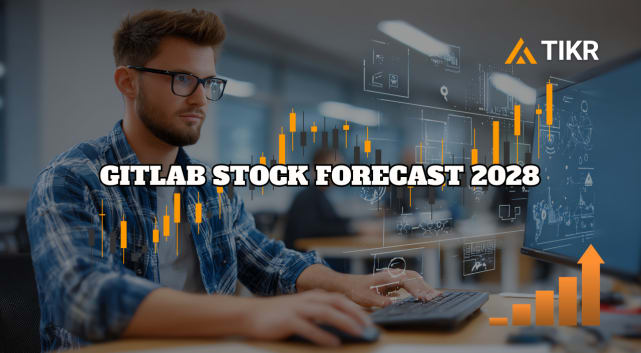SentinelOne (NYSE: S) has been under pressure over the past year. The stock trades near $17/share after a steady decline, driven by cooling growth, negative margins, and uneven cybersecurity spending. Even with these challenges, analysts still see room for recovery as the company focuses on efficiency and strengthens its platform.
Recently, SentinelOne reported results that showed meaningful operational progress. ARR and customer expansion remained solid, cost discipline continued improving, and enterprise adoption of the Singularity platform picked up. Management also highlighted early traction in new AI-driven security capabilities. These updates suggest the business is stabilizing even as software budgets remain tight.
This article explores where Wall Street expects SentinelOne to trade by 2028, using analyst price targets and TIKR’s Guided Valuation Model to outline the stock’s potential path.
Find out what a stock’s really worth in under 60 seconds with TIKR’s new Valuation Model (It’s free) >>>
Analyst Price Targets Suggest Meaningful Upside
SentinelOne trades near $17/share today. Analysts have an average price target of about $24/share, which points to meaningful upside of roughly 40%. Forecasts show a broad range and reflect mixed conviction across Wall Street:
- High estimate: ~$30/share
- Low estimate: ~$19/share
- Median target: ~$24/share
- Ratings: 19 Buys, 4 Outperforms, 12 Holds
Analysts see room for gains, but the wide spread in targets shows uncertainty around execution. For investors, this means the stock could remain volatile in the near term. The upside depends on whether SentinelOne can improve margins, expand enterprise adoption, and maintain stable demand across cybersecurity categories.

Discover how much upside your favorite stocks could have using TIKR’s new Valuation Model (It’s free) >>>
SentinelOne: Growth Outlook and Valuation
The company’s fundamentals point to steady improvement as it moves toward profitability:
- Revenue growth is projected at 20.3%
- Operating margins are expected to reach 7.6%
- The model uses a 62.3x forward P E multiple
- Based on analysts’ average estimates, TIKR’s Guided Valuation Model suggests about $26/share by early 2028
- That implies roughly 54% total returns, or about 21.5% annualized
These numbers indicate that SentinelOne can compound at a strong pace if it executes well. Growth is moderating, but the company is making progress on efficiency while maintaining solid demand for its platform. The valuation reflects expectations that profitability will continue improving as the business scales.
For investors, SentinelOne still looks like an early-stage compounder with room to grow. The long-term upside depends on management turning high gross margins and rising platform adoption into consistent operating leverage. If that plays out, the stock has meaningful potential over the next several years.

See a stock’s true value in under 60 seconds (Free with TIKR) >>>
What’s Driving the Optimism?
SentinelOne continues gaining traction across larger enterprises as customers consolidate security tools into unified platforms. Its strong gross margin profile provides room for future operating leverage, especially as management tightens spending. Adoption of the Singularity platform remains steady, supported by AI-driven capabilities that improve threat detection and response.
These strengths suggest SentinelOne has the foundation to stabilize results and gradually rebuild profitability. For investors, the company’s progress on efficiency and its position in a growing cybersecurity market offer reasons for optimism over the long term.
Bear Case: Profitability and Competition
Profitability remains the biggest concern. SentinelOne’s trailing EBIT margin is still negative, and the shift from hypergrowth to more moderate expansion puts pressure on management to improve margins quickly. The valuation is also elevated relative to near-term profitability, which adds risk if execution slows.
Competition is intense. CrowdStrike, Palo Alto Networks, and Microsoft continue investing heavily in threat detection and automation. For investors, the main risk is that slower adoption or pricing pressure could delay SentinelOne’s path to consistent profitability, making its current valuation harder to justify.
Outlook for 2028: What Could SentinelOne Be Worth?
Based on analysts’ average estimates, TIKR’s Guided Valuation Model using a 62.3x forward P E suggests SentinelOne could trade near $26/share by early 2028. That represents about 54% upside from today, or roughly 21.5% annualized returns.
This outlook assumes steady revenue growth and meaningful progress on margins. To deliver stronger upside, SentinelOne would need to accelerate profitability, expand enterprise deal sizes, and maintain consistent ARR momentum. Without that, investors should still expect solid but measured long-term returns.
For investors, SentinelOne appears to be transitioning from a high-growth, high-loss model toward a more balanced and scalable business. The long-term upside is compelling, but execution on profitability will determine how much of that upside is realized.
AI Compounders With Massive Upside That Wall Street Is Overlooking
Everyone wants to cash in on AI. But while the crowd chases the obvious names benefiting from AI like NVIDIA, AMD, or Taiwan Semiconductor, the real opportunity may lie on the AI application layer where a handful of compounders are quietly embedding AI into products people already use every day.
TIKR just released a new free report on 5 undervalued compounders that analysts believe could deliver years of outperformance as AI adoption accelerates.
Inside the report, you’ll find:
- Businesses already turning AI into revenue and earnings growth
- Stocks trading below fair value despite strong analyst forecasts
- Unique picks most investors haven’t even considered
If you want to catch the next wave of AI winners, this report is a must-read.
Find out what your favorite stocks are really worth (Free with TIKR) >>>








